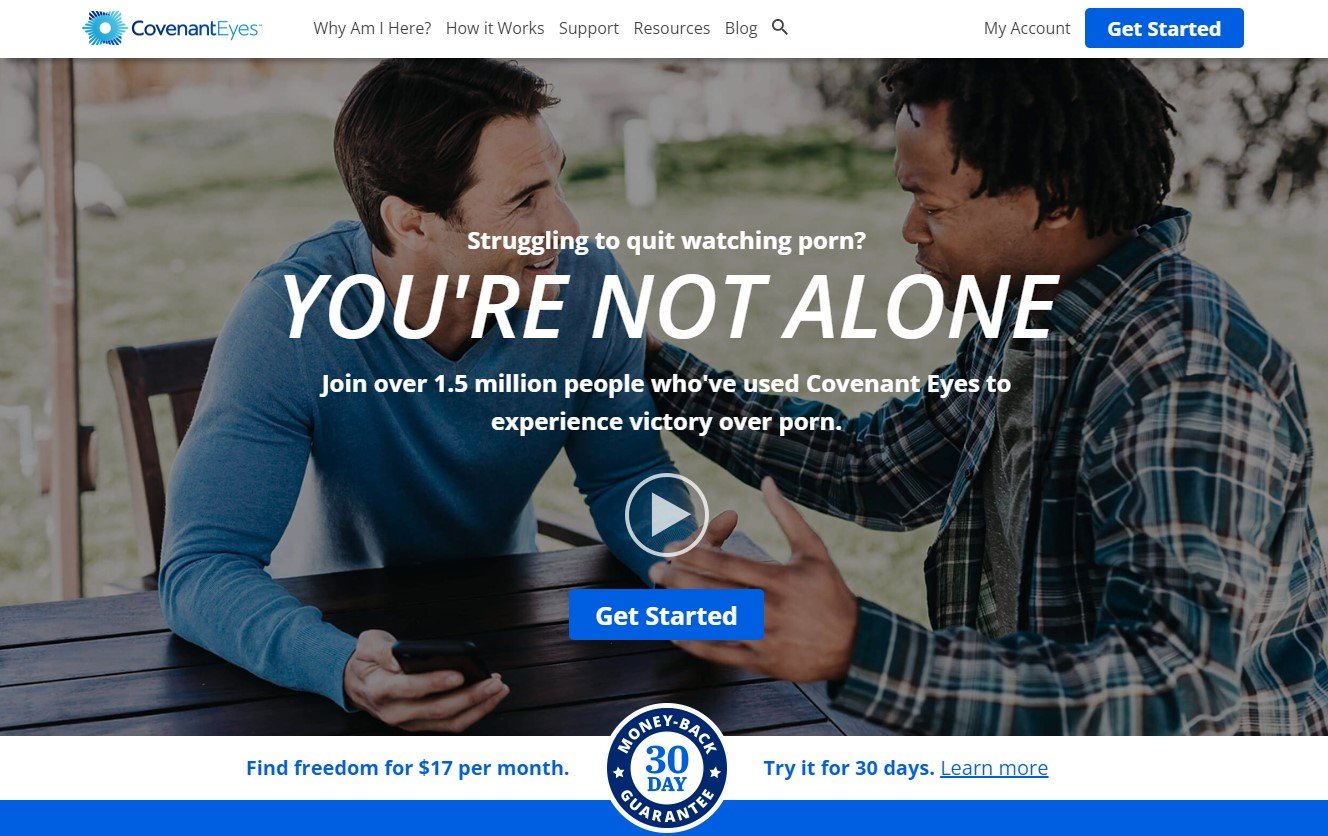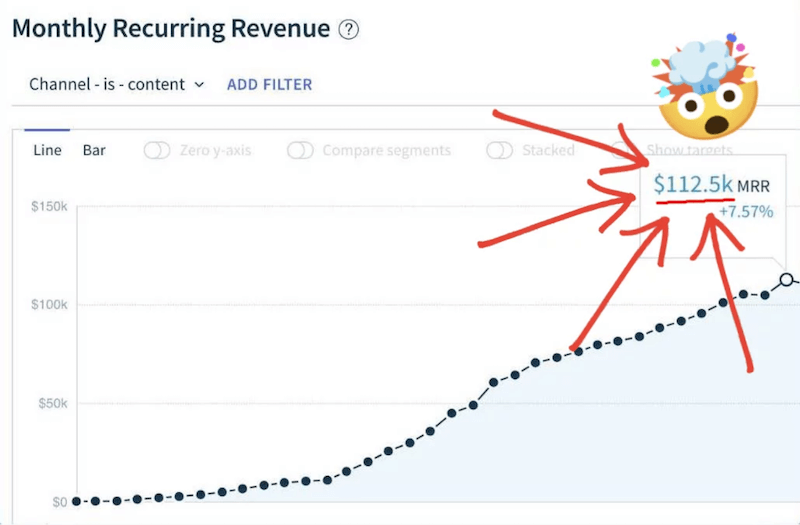In this post I’m going to show you how to help someone with a porn addiction in less than three minutes. Every time they’re exposed to pornography, you’ll be notified and they’ll get a warning like this:

Here are the exact steps to do it:
How to Help Someone With a Porn Addiction
1. Help Them Sign Up for Covenant Eyes
Begin by assisting the addict in creating a Covenant Eyes account. Navigate to the Covenant Eyes website and press 'Get Started'. Guide them through choosing a plan and setting up their account with their personal details.

2. Become Their Accountability Partner
Once their account is active, you'll need to become their accountability partner. In the 'Relationships' section of their account, have them invite you by entering your email address. Accept the invite to start monitoring their activity.

3. Install the Covenant Eyes App on Their Phone
Now, install the Covenant Eyes app from the App Store or Google Play onto their phone. Once installed, help them log in with the account details they created. Make sure the app is installed on all devices they use.

4. Set Up Protection Measures
With the app installed on their phone, go through the settings together. Set up the appropriate filtering levels and monitoring to help protect them from unwanted adult content.

5. Download the Victory App for Yourself
As their accountability partner, install the Victory app on your own phone. This companion app will allow you to view their activity feed, receive alerts, and access educational materials to better support the porn addict.

That’s it!
Porn Blocking In Action
Here are some examples of the ways Covenant Eyes works:

Activity feed, which is a scrollable list of the member's device activity.

Harmful activity notifications, in the form of a push notification to the ally’s device from the Victory app.

Activity summary
What is considered porn addiction?
Porn addiction is a form of behavioral addiction that involves compulsive engagement with pornographic content, despite negative consequences to the person's mental health, relationships, and daily life. Unlike casual or occasional consumption of pornography, which might not interfere with a person's well-being or responsibilities, porn addiction is characterized by an inability to control the urge to view pornographic material. This compulsive behavior is similar to other addictive behaviors seen in substance use disorders or gambling addiction, where the individual continues the activity despite knowing its harmful effects.
This condition is recognized by mental health professionals as a serious issue that can lead to mental health disorders, including hypersexual disorder or other sexual behavior issues. People with porn addiction may experience symptoms similar to those of other addictions, such as feelings of shame, guilt, isolation, and loneliness. These feelings can exacerbate the addiction cycle, as individuals may use pornography as a way to cope with negative feelings, further deepening the addiction.
Behavioral addictions like porn addiction can impact daily life significantly, affecting personal lives, intimate relationships, and even physical health. The addictive cycle is often maintained by the immediate gratification that porn consumption provides, which can interfere with the ability to form or maintain healthy relationships and engage in normal life activities.
How to talk to someone with a porn addiction?
Talking to someone with a porn addiction requires sensitivity, understanding, and a supportive approach. It's essential to approach the conversation from a place of compassion rather than judgment. Here's how you can navigate this delicate conversation:
- Choose a safe space: Find a private and comfortable setting for the conversation. It's important that the person feels safe and not at risk of public embarrassment or judgment. This safe space encourages openness and honesty.
- Express concern, not judgment: Begin by expressing your concerns without making the person feel judged. Use "I" statements to convey how you feel and what you've noticed, rather than accusations. For example, "I've noticed you seem a lot more withdrawn lately, and I'm worried about you."
- Use understanding language: Acknowledge that porn addiction is a real and challenging issue, similar to other forms of addiction such as substance use disorder or gambling addiction. It's crucial to recognize that overcoming porn addiction involves dealing with addictive behaviors and mental health issues, and not just a matter of willpower.
- Encourage professional help: Suggest the possibility of seeking help from a mental health professional or addiction therapists. Professionals trained in dealing with behavioral addictions, like porn addiction, can offer the necessary guidance and treatment options. Covenant Eyes, a tool designed to help people quit porn through accountability and content filtering, can also be part of the conversation. It's a practical step towards recovery, emphasizing the importance of external support in overcoming addiction.
What are the signs of a porn addiction?
Recognizing the signs of porn addiction is crucial for understanding when someone might need help. Porn addiction, similar to other behavioral addictions like gambling addiction or internet addiction, manifests through various behavioral, emotional, and social symptoms. Here are key signs that may indicate a porn addiction:
- Compulsive behavior: An overwhelming urge to view pornographic content, even in situations where it is inappropriate or disruptive to daily life. The individual may spend an excessive amount of time searching for, viewing, or engaging in activities related to pornography.
- Neglect of responsibilities: Neglecting personal, professional, or educational responsibilities due to time spent on pornography consumption. This might include poor performance at work or school, missing deadlines, or neglecting household chores.
- Relationship problems: Porn addiction can lead to unhealthy relationships with partners, family, and friends. It may cause secrecy, lies, or a decline in intimacy and sexual satisfaction within intimate relationships, leading to conflicts or isolation.
- Increased tolerance: Similar to substance use disorders, individuals may experience a need for an increased amount or more explicit content to achieve the same level of satisfaction or excitement, indicating a tolerance that has developed over time.
- Withdrawal symptoms: Experiencing emotional or physical distress when unable to access pornography, such as anxiety, irritability, mood swings, or restlessness, can be a sign of addiction.
- Failed attempts to stop: Repeated unsuccessful efforts to reduce or stop pornography consumption, despite recognizing its negative impact on one’s life, may signify a possible addiction.
How to help someone with a porn addiction?
Helping someone with a porn addiction is a delicate process that requires empathy, understanding, and support. The first step is creating a safe and private environment where the person feels comfortable discussing their struggles without fear of judgment or exposure. This safe space is crucial for open and honest communication. It's essential to approach the conversation with care, ensuring the individual knows you're coming from a place of concern and not criticism. Use "I" statements to express your observations and feelings, which can help prevent the person from feeling attacked or defensive.
Understanding and empathy are key in these discussions. Acknowledge that porn addiction is a real and complex issue, similar to other addictive behaviors like substance use or gambling addiction. It's not just about willpower but involves a range of psychological and emotional factors. Encouraging the individual to seek help from a mental health professional or addiction therapist can be a significant step. Professionals who specialize in behavioral addictions have the knowledge and tools to provide effective treatment and support.
Introducing resources such as Covenant Eyes can be particularly helpful. Covenant Eyes offers tools designed to help individuals overcome porn addiction through accountability and filtering mechanisms. Recommending such resources shows your support for their journey towards recovery and underscores the importance of professional help and external support systems in overcoming addictive behaviors. Your role in providing a supportive and non-judgmental environment can make a crucial difference in encouraging someone to take the first steps towards healing and recovery from porn addiction.
What is the best software to help someone with a porn addiction?
We ranked and reviewed the best accountability apps in this article.

